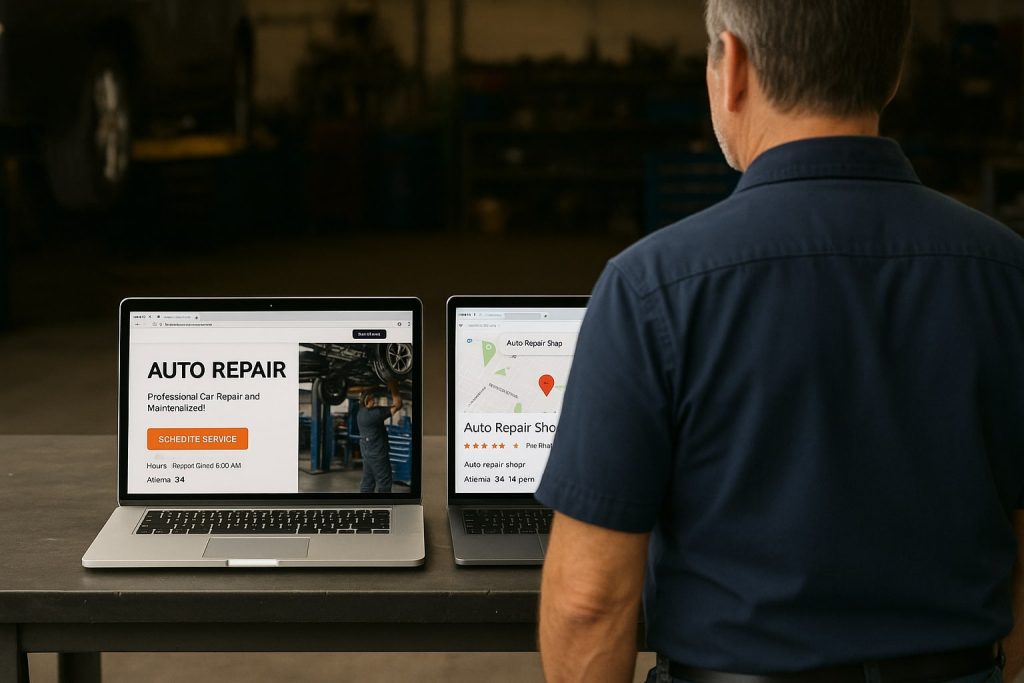Why Google Maps Ranking Matters More Than Your Website

Ever pulled up Google on your phone for “brake repair near me” and clicked the first shop that pops up on the map? You’re not alone—most folks do the same, skipping fancy websites altogether. In local marketing for auto repair shops, nailing your Google Maps ranking can mean the difference between a full bay and crickets, often trumping even the slickest site. We’ll dive into why Maps reigns supreme, how ratings play into it, what sways your spot, and how to snag more clicks to keep your phone ringing.
Contents:
- Why Google Maps Trumps Your Website in Local Marketing
- How Google Maps Rankings Actually Work
- The Power of Ratings and Reviews in Maps Ranking
- Key Factors Influencing Your Position in Maps
- Step-by-Step: How to Climb the Maps Ranks and Get More Clicks
- Tools and Tips for Auto Repair Shops
- Conclusion: Prioritize Maps for Real Results
- FAQ: Google Maps Ranking for Auto Repair Shops
Why Google Maps Trumps Your Website in Local Marketing
Picture a harried driver with a flat tire—they’re not scrolling through websites; they’re tapping Maps for the closest fix. Google Maps ranking for auto repair shops grabs 42% of all clicks in local searches, far outpacing organic website results. That’s because the Map Pack—the top three spots—shows up first, with easy calls, directions, and reviews that build instant trust.
Websites are great for deep dives, but in 2025, 46% of searches are local and mobile-driven. A top Maps spot drives 7x more clicks than a half-baked profile, turning searches into walk-ins faster than a site buried on page two. Take a shop in Boise: They optimized Maps over their site revamp and saw calls jump 25%—proof that visibility beats bells and whistles.
How Google Maps Rankings Actually Work
Google Maps isn’t random—it’s a smart algorithm prioritizing relevance, distance, and prominence for every query. For auto repair shops, this means your Google Business Profile (GBP) is the star, matching searches like “oil change [city]” to show you first.
Ratings? They’re baked into prominence: High stars (4+ average) from recent, detailed reviews signal you’re a go-to spot. Google scans review text for keywords like “fast brake repair,” boosting your fit for those searches. It’s not just quantity; quality and responses matter, turning feedback into ranking fuel.
The Power of Ratings and Reviews in Maps Ranking
Ratings are your Maps superpower—nearly 74% of folks read reviews before choosing a shop. A 4.5-star profile with fresh praise outranks a 3-star one, as Google weighs sentiment, volume, and recency in prominence.
Pros? High ratings craft AI summaries like “ASE-certified techs with fair prices,” drawing clicks from “mechanic near me” hunts. One Alpharetta shop hit 4.8 stars and dominated “BMW repair” results, boosting conversions by 20%. Negative? Low scores bury you, so respond professionally to flip complaints into wins.
Key Factors Influencing Your Position in Maps
Your Maps spot hinges on three pillars: relevance, distance, and prominence. Nail these, and you’re golden for local Google Ads mechanic tie-ins.
- Relevance: How your GBP matches searches—use exact categories like “Auto Repair Shop” and keywords in descriptions.
- Distance: Proximity to the searcher; accurate NAP and service areas expand your reach without moving.
- Prominence: Reviews, backlinks, photos, and engagement like posts signal popularity. Consistent citations on Yelp or RepairPal amp this up.
Other influencers? Mobile-friendliness and fresh content—Google favors active profiles for 2025’s AI-driven searches.
Step-by-Step: How to Climb the Maps Ranks and Get More Clicks
Boosting your google maps ranking auto repair style? Follow these steps, blending GBP tweaks with smart tactics.
- Claim and Optimize Your GBP: Fill every field—hours, services, photos. Add geo-keywords like “brake repair [city]” to descriptions for relevance.
- Hunt for Reviews: Ask post-service via text or email; incentives like oil change draws boost by 50%. Respond to all for engagement.
- Post Regularly: Share tips or specials weekly—keeps you fresh and clickable.
- Build Citations and Backlinks: List on directories; partner locally for links, lifting prominence.
- Track and Tweak: Use GBP insights or tools like Local Rank Tracker to spot weak spots and adjust.
A Phoenix shop followed this and climbed to top 3 in two months, snagging 30% more clicks.
Tools and Tips for Auto Repair Shops
From our local SEO tools roundup, grab these for Maps mastery: Google Business Profile (free essentials), BrightLocal for citations, and Semrush for tracking. Pro tip: Embed Maps on your site for extra signals, even if it’s basic.
Maps Ranking Factors Table for Auto Shops
| Factor | What It Means | How to Optimize |
|---|---|---|
| Relevance | Profile matches search | Keywords in desc, categories |
| Distance | Closeness to user | Accurate NAP, service areas |
| Prominence | Online rep and activity | Reviews, posts, backlinks |
Conclusion: Prioritize Maps for Real Results
In local marketing, google maps ranking auto repair shops beats a standalone website hands down—it’s where decisions happen. Focus here to capture those urgent clicks, blending with your Google Ads for auto repair shops for max impact. Your bays will thank you.
Loved this? What’s your Maps hack? Comment below and subscribe for more shop tips. Optimize your profile today—let’s get you ranking!
FAQ: Google Maps Ranking for Auto Repair Shops
Why does Maps ranking beat having a fancy website?
Maps grabs 42% of local clicks instantly, while sites often get overlooked in mobile searches. It’s quicker for urgent fixes like brakes.
How do reviews affect my Maps position?
They boost prominence—high stars and fresh feedback push you up, with AI summaries highlighting strengths.
What quick wins boost my Maps clicks?
Optimize GBP with photos/posts, get reviews, and build citations—expect 7x more engagement.
Can I rank well without a website?
Yes! A strong GBP alone dominates local packs, but linking a simple site adds credibility.